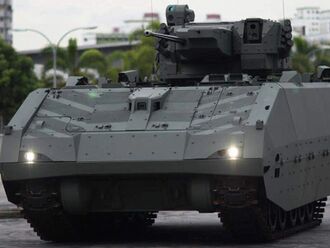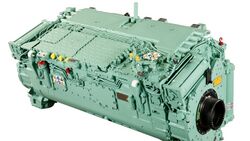C220 Rocinante II
| C220 Rocinante II | |
|---|---|
 A C220-C on display at ALTAREX 2020 | |
| Type | Armoured fighting vehicle |
| Place of origin | |
| Service history | |
| In service | 2020-present |
| Used by | |
| Production history | |
| Designer | Cavallero Heavy Auto |
| Designed | 1960-2018 |
| Manufacturer | Cavallero Heavy Auto |
| Produced | 2019-present |
| Variants | C220-A C220-B C220-C C220-AA C220-H C220-M |
| Specifications | |
| Weight | 22 tonnes (Level I: baseline armour) 24 tonnes (Level II: composite applique) 28 tonnes (Level III: composite & ERA) |
| Length | 5 m (16 ft) |
| Width | 2.8 m (9.2 ft) 3.6 m (12 ft) (Level-III applique) |
| Height | 3 m (9.8 ft) (max) 2.6 m (8.5 ft) (min) |
| Crew | 2-3 (commander/gunner & driver or commander, gunner, driver) |
| Passengers | 10 |
| Armor | Level-I: HHS strike face with Aluminium 8009 inner plate Level-II: applique ceramic composite armour Additional applique explosive reactive armour |
Main armament | C220-A: 1 × 12.7×99 mm machine gun (remote weapon system) C220-B: 1 × 40×53 mm grenade machine gun, 1 × 6.8×43 mm co-axial machine gun C220-C: 1 × Arx AC-30-II 30×250 mm chain gun (remote turret), 1 × 8.6×70 mm co-axial machine gun C220-AA: 1 × Arx AC-35-III 35×228 mm chain gun, 2 × FIM-92 C220-M: 4 × MMP/MST-200, 1 × 8.6×70 mm pintle-mounted machine gun |
| Engine | Cavallero CAV-AFV220 twin-turbocharged 12.3-litre diesel V6 engine 500 hp (370 kW)/2600 rpm 550 hp (410 kW)/2800 rpm |
| Power/weight | Baseline: 22-25 hp/tonne |
| Transmission | Denk Hiswel G256 15-30 (automatic, 6-speed forward & reverse) |
| Suspension | torsion bar, 2 × set of 5 road wheels |
Operational range | A1 (Level-II): 385 km (239 mi) |
| Speed | Road: 70 km/h (43 mph) Wading: 5.8 km/h (3.6 mph) |
Steering system | Drive by wire |
The C220 Rocinante II is a Armoured fighting vehicle produced by Cavallero Heavy Auto. It is the product of a modernisation programme aimed at improving the older Matapon TOMP-IV Diokles, a Tagmatine Armoured Personnel Carrier. The vehicle entered pre-production in 2019 and entered service with the Iverican Army and the Republican Marine Regiments in 2020.
The C220 is a direct development based on the TOMP-IV, sharing its general chassis layout and silhouette. The vehicle was also designed to retain key design features from the Diokles, namely its relative low mass and compact profile. It also incorporates advancements, featuring improvements centred on protection, sensor technology, drive train, and armament mounting. In Iverican service, the C220 is used to supplement parachute infantry, mountain infantry, breacher-engineer, and amphibious expeditionary units.
History
Cavallero announced the programme at the 1998 Altaria Arms Expo (ALTAREX) as the Rocinante Project, and subsequently revealed the C200 Rocinante at the 2000 ALTAREX. Though originally announced as a technology demonstrator and compentency showcase, repeated interest in the project prompted Cavallero to design a more advanced unit with the intention of mass-production. The new design was entered in in a 2008 preliminary bid to the Iverican Ministry of Defence as the C220 Rocinante II. The C220 design passed Ministry reviews in 2010 with Cavallero receiving second-stage funding for continued development by 2011. The vehicle entered pre-production in 2019 and entered service with the Iverican Army and the Republican Marine Regiments in 2020.
In later public commentary, Cavallero revealed that the Rocinante Project had not been intended for full production and had only received funds from the company's marketing budget and not its R&D budget. Cavallero revealed that initial funding for the C200 technology remonstrator had been $1.9 million ADS issued as a marketing initiative and had been constructed outside of the design team's billed hours, initially as a recreational project with a TOMP-IV chassis purches from Ee-bay.
Design
Cavallero intended for the C220 to offer modern technical solutions and design innovations to the proven but dated design of the TOMP-IV. New material technology for the C220's composite armour package and composite rubber track system are notable enhancements. Since the TOMP-IV's entry into service in 1960, significant improvements in the reliability and efficiency of modules like the power plant and transmission allowed Cavellero to introduce a higher power twin-turbocharged V6 plant and a hybrid, computerised, electronic torque converter automatic transmission to replace the TOMP-IV's naturally-aspirated 6-cylinder and mechanical torque converter respectively. Advancement in armament technology also allowed for the mounting of lightweight remote systems where larger directly-manned systems would have been necessary.
Mobility
Retaining a similar roadwheel layout and size, a similar suspension system, and an identical drive train layout, the C220's drive system is a direct enhancement based on TOMP-IV's drive system. Modularly, it's main differences include the track system, the power plant, and the transmission module. Minor changes include a more robust final drive gearset made from milled stainless steel alloy and roadwheels with a new mould featuring lightening cuts.
Running Gear
The primary difference in running gear is the replacement of steel tracks with a composite rubber track system. The new CRT pair is has a pitch of 190mm, a width of 390mm, and a height of 150mm (including the guide lugs and grousers), these tracks are wider than the T130E1 tracks used on the TOMP-IV. The CRT used on the C220 was designed and manufactured by DuraMat, which provides a similar design to Arx Arms Manufacturing for the UC-42 Léon and the UC-30 Pantera.
The C220's CRTs are comprised of a layered mesh of soft metals, rubber, plastics and fabrics. The construction of the tracks is laminated, with meshes layered together and reinforced by a range of composite materials including carbon fibre and carbon nanotubes, as well as longitudinal and lateral steel cords, or ‘belting’. Above and below the belting are multiple layers of steel mesh configured to resist track twisting and maximise the longitudinal torsional stiffness of the track matrix. The C220's tracks are designed for vehicles weighing up to 30 tonnes. It uses more than 12 separate rubber compounds with an overall composition of approximately 49% rubber, 29% steel and 22% composites. A range of rubber compounds are used throughout the track matrix, with stiffer compounds in the lug cores and softer, more pliable, and UV-resistant compounds on the surface. Those elements, interfacing with moving parts such as the surface of the drive lugs that engage with the drive sprocket, use compounds that have high resistance to abrasion, a low friction coefficient, and are self-lubricating. The typical life of CRT on the C220 vehicles of up to 28,000 kg is approximately 7,000 km up to a max of 9,000 km.
An auto-tensioning system reduces the probability of the CRTs becoming dislodged from the rest of the running gear. A pair of hydraulic-electric pistons can move the idlers to increase or decrease tension. The system uses a pressure sensor to ensure that track tension is always exact and remains constant throughout the track wear cycle. It also makes replacing an entire track system easier as the driver is able to remove tension entirely.
The relative softness of the CRT system reduces the C220's wear on road systems and civilian infrastructure, while also reducing the vehicle's overall mass and increasing fuel efficiency.
